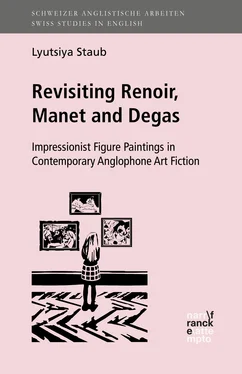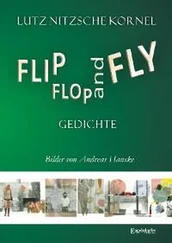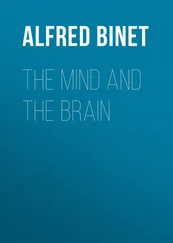Finally, the fifth chapter investigates how the re-presented artworks are perceived and interpreted by various actants and how the Impressionist art movement in general is commented upon in the narratives. The use of actually existing works of art in fiction allows novelists to explore and recycle ready-made interpretations of the image and, by using them as a foundation, create new meanings of a re-presentation. However, regardless of the derivation (ready-made or newly created) of the meaning, it is generally conditioned by a certain framework used for viewing art pieces and is thus determined by art historical method. The discussion will include the most popular and influential art historical methods usually used in regard to Impressionist paintings, such as connoisseurial (or biographical), formalist, iconographical, Marxist, social art history and feminist methods. This part will examine which approaches the novelists apply and in which combinations, what effects they create in the narrative and, most importantly, if and how they embellish the understanding of the re-presentation. Therefore, central questions raised within the interpretive category are: who are the transmitters; what type of transmission is offered; how do interpretations given by characters differ, and what impacts do they exert?
Within this section I will focus on the issue of the perceived versus intended meaning of an artwork, considering a painting to be a visual form of communication between a sender-artist and a receiver-viewer, in which the viewer is invited to decode or translate the message the artist has intended to send. The study will show how meaning making occurs in fictional visual communication, and suggest that the perceived meaning of an artwork is relative to the artist’s intentions, standard conventions, established systems of painting, familiar socio-cultural circumstances, and the viewer’s aesthetic values and ability to interpret. Moreover, it will draw a conclusion as to how the meaning given to re-presentation supplements the way the original extant artwork is perceived and interpreted. Furthermore, this chapter focuses on the paintings viewed on display (in either museum spaces or the painter’s studio) and the resulting multiple interpretations. The analysis intends to explain how the spatial distance dictated by museum culture (the viewer’s inability to touch the object), the temporal distance established via the separation of an object from the artist’s labour (experiencing the ready-made artwork not in the process of its creation) and the viewer’s emotional and aesthetic distance to the art object influence the understanding of the art piece.
In addition, I will explore the effectiveness of making characters revisit the same image and look at collections in the narratives. The discussion will centre on the re-presentation of Impressionism through the interpretation of artworks of several artists. It will argue that the novels introduce the readers to a heterogeneous group of painters, allowing readers to see the contrast between the individual styles, techniques, depicted subjects and artists’ intentions, and hence enrich the assembled collection of re-presented artworks, on the one hand, and extend the reader’s knowledge about the Impressionist art movement in general on the other. Additionally, this section investigates the historical and socio-cultural re-presentation of Impressionism through the medium of art criticism illustrated in the novels, seeing it as an ekphrastic meta-commentary on both a specific work of art and art movement. It is interesting to see how a combination of historically accurate settings, factual knowledge of Impressionism, authentic information about the paintings and fictional stories around them complement each other and eventually manipulate the reader’s understanding of the re-presentations. Ultimately, this study deliberates the question whether contemporary art fiction, which re-presents and interprets actually existing works of art through the lens of contemporary culture, can be considered a new guide to understanding art, acknowledged as a distant form of art history, seen as a contemporary aesthetic discipline or simply regarded as an à la mode intermedial product.
Chapter 2. Intermediality: Narrative Texts and Visual Arts
2.1. Visual and Verbal Overstepping of Boundaries
[P]ainting and writing have much to tell each other; they have much in common. The novelist after all wants to make us see. (Woolf 22)
Visual art has never been as quantitatively and qualitatively available as in the twenty-first century. Due to its accessibility beyond the traditional gallery walls, art has become a desired, inseparable part of one’s everyday life. It is no longer possible to speak about an artwork being unique, nor is it necessary to go to the gallery to see the original, as “the uniqueness of the original now lies in it being the original of a reproduction ” (Berger 21). Not only are the most famous masterpieces copied, photographed and reproduced, but due to the advent of online galleries, they are also visible on a round-the-clock stage. The fact that works of art are reproducible and easily accessible allows for them to be used and recycled in many possible ways. Therefore, it is not surprising that visual art penetrates the works of contemporary writers, whose texts serve as representative examples of intermedial relations between visual works of art (paintings) and narrative texts.
However, the semiotic differences between the two media have given cause for serious concern among scholars: “A great concern with the production and understanding of painting as a visual text to be decoded seems to lie at the heart of the [contemporary] novel, constituting as it does one particular form of a general epistemological questioning” (Wagner, Icons – Texts – Iconotexts 9). This concern demands that the very concept of intermediality be defined. Wolf proposes two definitions of intermediality: an ‘intracompositional’ definition that dislimits intermediality in a narrow sense while focusing on “the participation of more than one medium within a human artefact” (“Relevance of Mediality and Intermediality” 19) and, opposing it, an ‘extracompositional’ definition of intermediality, which, taken in a broad sense, “applies to any transgression of boundaries between conventionally distinct media […] and thus comprises both ‘intra-’ and ‘extra-compositional’ relations between different media” (19). Intermediality in its narrow sense deals with a concrete cultural product and its functions in a literary text, such as in evocative descriptions of a work of art, formal imitation through structural analogies to an artwork, reproduction or re-presentation of a work of art, and discussions about it within a novel (32). Since the ‘intracompositional’ definition of intermediality presupposes directing all attention to the actual subject matter captured directly in both media, it is more suitable for the purposes of the present study, which brings the variety of ekphrastic relationships in contemporary art fiction into sharper focus.
In the same vein, in discussing intermediality, Horst emphasises not only the idea of the “fusion of the different media” (19), but also recognition of the fact that a combination of two media gives birth to something new (19). In general, therefore, it seems that an artefact that integrates two or more medial forms may be regarded as intermedial, and can be expected to produce new meaning in a cultural product in any given medium. However, since each medium carries a dissimilar semiotic system in itself, any combination of media inevitably provides potential for new interpretations. Wolf maintains that in the process of framing and transmitting information, media extend and intensify the message as well as become an integral part of its meaning:
Читать дальше












